MINNEAPOLIS — From where Whit Merrifield stood, it was just like what happened the other night.
In the top of the eighth inning Thursday, during Merrifield’s first game with the Toronto Blue Jays, he shot a 98-m.p.h. Trevor Megill fastball into right for a single, moved to second on a base hit, and took off sprinting for third when George Springer snuck a groundball through the left side.
As he rounded the bag, Merrifield picked up his third base coach, Luis Rivera, waving him through. Next, he shifted his sights to home plate, where he saw Minnesota Twins catcher Gary Sanchez setting up right on top of it.
“Gary was straddling home plate then, as well,” Merrifield remembered. “But the throw was cut off, so there was no play at the plate. But, in the back of my head, I was a little bit aware of how he sets up at home. And I had a feeling…”
Merrifield trailed off. It was about 20 minutes after the Blue Jays won Sunday’s dramatic matinee with the Twins, 3-2, to split an intensely contested, back-and-forth series played in front of rowdy, packed houses between two teams built for deep postseason runs. Over four days in Minneapolis, there were 38 runs scored, 9 lead changes, two extra-inning games, and a riveting, controversial play at the plate to cap it all off. It felt like a big series.
“It did, it did,” Merrifield said. “This is a really good team, Minnesota. And they’re in the middle of the playoff hunt as well. It felt like one of the bigger series I’ve played in a while.”
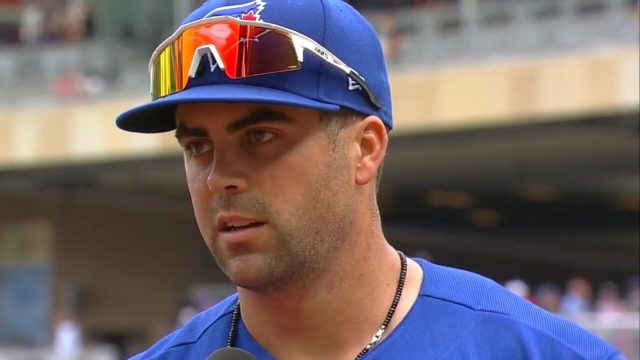
From where Luis Rivera stood, he saw an infielder playing left field.
Down one in the bottom of the ninth Sunday, the Twins rallied against Blue Jays closer Jordan Romano, stringing together a hit by pitch and a pair of singles to scratch across a game-tying run. Tim Beckham, pinch-running for Carlos Correa who led off the inning with the hit by pitch, was that run. And he stayed in the game for the top of the 10th, heading out to left field to take over for Jake Cave, who Correa pinch-hit for.
Rivera saw Beckham jogging out there and made note of it. He knew Beckham had spent the majority of his career at shortstop, second base, and third. He also knew Beckham had played a little bit of outfield, but not much. What were the odds he was ready to make a throw?
“I figured he didn’t have too many repetitions over there,” Rivera said of Beckham, who entered the game with 94 career innings in left field but only three this season. “And we’ve got a good runner at third. So, thinking about the situation, I thought we could take a chance with those guys.”
Plus, Rivera had just watched Merrifield go second to third on a Santiago Espinal fly ball to Byron Buxton in centre. The ball wasn’t hit particularly deep, and Buxton has a cannon — his throw to third from an outfield depth of 320-feet measured 93.7-m.p.h. — but Merrifield still raced head-first into the bag right in front of Rivera, as the Blue Jays coach extended his arms motioning safe before the third base umpire had even made up his mind.
“It wasn’t very deep. I thought he was just going to fake it. I didn’t think he was actually going to do it,” Rivera said. “And then he goes and I thought, ‘Oh, my goodness. This guy is fast.’”
Quick sidebar about Merrifield tagging up to third: that was the more challenging read than the choice to try for home. And Merrifield almost didn’t go for it. He knows the kind of arm Buxton has. But when he saw the Twins centre fielder drifting back and to his left while tracking the ball, he made a quick, last-second decision to be aggressive.
“I knew that he’d been on the bench all day. So, I knew he might not have been fully ramped up,” Merrifield said. “But he's one of the best out there. He made a great throw and, fortunately, I just beat it. I got to third, I’m watching the replay going, ‘Hoo, that was a little closer than I would have liked it to have been.'”
Or, as Rivera put it: “That was the game. That made the difference. Because if he stays at second base, we would never have had a play at home.”
Right, back to the play at home. After the razor-thin safe ruling on Merrifield’s slide into third was confirmed, the very next pitch was lifted high into left field by Cavan Biggio. And as Rivera saw that infielder playing outfield settling under it, he didn’t think twice.
“When the ball went up in the air, I made up my mind right away that we were going to challenge him,” Rivera said. “And, you know what, he made a pretty good throw.”
Beckham did, firing a seed at 88.4-mph on a line to Gary Sanchez at the plate, as Merrifield charged down the third base line moving 29.3 feet per second.
You’ve obviously seen what happened next. Foot-first slide; Sanchez’s knee down in front of the plate; home plate umpire Marty Foster signalling out; Merrifield sitting in the dirt pointing at home; the Twins jogging off the field to celebrate.
“I was saying, ‘He’s blocking the plate! He’s blocking the plate!” Merrifield remembered. “And [Foster] said, ‘Yeah, they’re going to look at it. They’re going to look at it.’ So, they looked at it.”
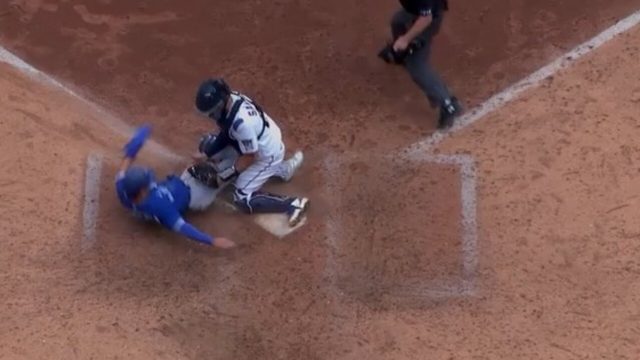
From where John Schneider stood, he felt he had a pretty good look at it himself.
“I went out and [crew chief Alan Porter] said, ‘What are you challenging? Safe or the slide rule?’” Schneider recalled. “And I said, ‘Slide rule, for one. I don't think he got to the plate.’”
There was no argument that Merrifield got in under Sanchez’s tag. His feet may have never even touched the plate at all. But to the Blue Jays, that was irrelevant. They felt Sanchez had obstructed Merrifield’s path home.
As you will find on page 73 of MLB’s rulebook, “unless the catcher is in possession of the ball, the catcher cannot block the pathway of the runner as he is attempting to score. If, in the judgment of the umpire, the catcher without possession of the ball blocks the pathway of the runner, the umpire shall call or signal the runner safe.”
Merrifield’s well aware of this rule. Just as, remember, he was well aware of how Sanchez tends to set up when preparing to receive a throw at the plate. Both those things entered his mind as he was sprinting to the plate. And in a split-second decision, Merrifield decided the best thing he could do was slide feet-first in the direction of the plate, which Sanchez’s knee was dropping in front of.
“I saw Gary straddling home plate. So, I tried to just slide in to him straight in as best I could,” Merrifield said. “I know what the rule is. It was just a matter of whether they were going to call it or not.
“Obviously, it's a big point in the game and you don't want it to come down to a rule decision. But the rule's there for a reason. It wasn't there a while ago. I could have run him over and tried to free the ball. But can't do that anymore. So, he's got to give me a lane to slide in. And I didn't think I had one.”
MLB’s Replay Command Centre in New York agreed. They judged that Sanchez’s “movements into foul territory were not in reaction to the trajectory of the throw and he did not have to be in that position to receive the ball. The catcher’s actions while not in possession of the ball hindered and impeded the runner.”
Target Field was bedlam. Half Twins fans booing the umpires; half Blue Jays fans — having made the trip south from Saskatchewan, Manitoba, and Western Ontario — celebrating the outcome. In the Blue Jays dugout, Schneider wasn’t surprised.
“I think the call was correct. That's why they have the rule in place,” Schneider said. “And credit to Witt for, A, getting to third on the fly ball to center on Buxton. And then, B, sliding correctly into home, which I think made that play a little bit more relevant. That's what we saw live and in person and it was confirmed on video. The rules are the rules. And I'm glad that Whit did it the way he did.”
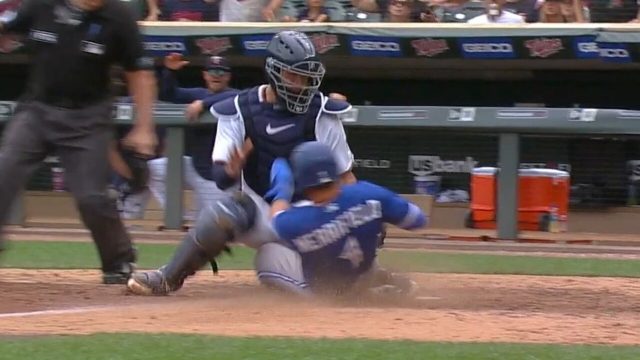
From where Rocco Baldelli stood, it was, ahem, “one of the most chickenshit things I’ve ever seen on a baseball field.”
Oh, and the Minnesota Twins manager went on.
“That play has not been called since the beginning of replay more than a couple of times. In all of baseball, the thousands and thousands of games, and plays at home where the catcher actually does block the plate, over and over and over again, that play has virtually never been called,” Baldelli said.
“And for someone to step in, in that situation, and ultimately make a decision that that was blocking the plate — that’s beyond embarrassing. For our game. For all the players out there on both sides of the field working their ass off. For the entire game. It’s completely unacceptable.”
It really says something about the equivocal gray area this particular rule exists in that, simultaneously, to those wearing blue the play was correctly judged to the letter of the law, and to those wearing red it was royally botched beyond comprehension. There was no ambiguity. Both sides were completely convicted.
Baldelli was as incensed as anyone’s ever seen him, storming around home plate, whipping his hat, screaming at the umpiring crew, and even pointing angrily up at the press box — likely in a motion to New York’s Replay Command Centre — throughout a multiple-minute tirade.
The Twins manager said following the game that his anger stemmed largely from a belief that the home plate collision rule is rarely enforced. Meanwhile, a few states over to the east on Sunday afternoon, a seventh-inning out call at the plate was overturned in Baltimore when replay review determined Orioles catcher Robinson Chirinos had blocked the plate.
“It’s one of the worst moments I think we’ve seen of umpiring in any game I’ve been a part of in baseball,” Baldelli said. “I think it was pathetic what just played out.”
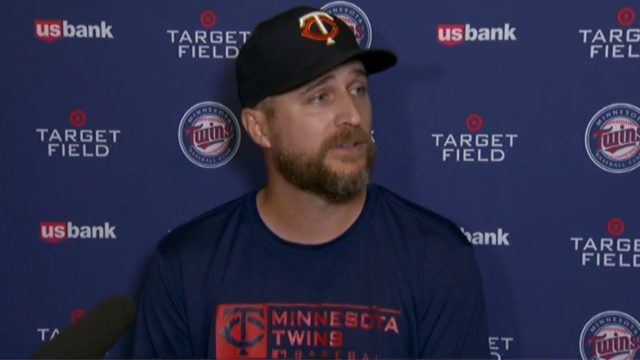
From where Jordan Romano stood, the mayhem was a welcome distraction.
The Blue Jays only found themselves in that 10th inning spot because Romano couldn’t convert his 29th save opportunity of the season a half-inning earlier. Taking over in the bottom of the ninth with a one-run lead, Romano hit Correa with an 0-2 heater, before letting the pinch-runner Beckham round the bases on groundball singles by Sanchez and Luis Arraez.
Romano was fuming. Of course he was. But with the game tied and two runners on, he settled in and executed a pair of well-located sliders to Jorge Polanco and Max Kepler, getting two more groundballs that this time found infielders and kept the game tied.
As Romano got back to the dugout steps, Schneider and Blue Jays pitching coach Pete Walker told him to wash it and stay dialled in. He was going back out for the 10th.
“It’s kind of tough because you’re so pissed off that you gave up the run when we definitely should have won that game right there,” Romano said. “But I gave myself a minute just to process everything. It's like, ‘All right, I gave up the run. It sucks. Whatever.’ And then it's like, 'All right, who we got up next?'”
The answer was Jose Miranda, Nick Gordon, and Gio Urshela while protecting another one-run lead, only this time with the degree of difficulty increased by a runner starting the inning at second base.
It was a lot to process — turning the page from the failure of an inning prior and preparing himself to try again in an even more challenging situation. After the game, Romano didn’t have a particularly clear memory of Merrifield’s play at the plate. He was still in his own world at the time, working through the emotions.
“It’s tough to turn the page — that inning would always keep creeping back in and I’d get pissed off again,” Romano remembered. “But I had to tell myself, you know what, that’s over. You’ve got a new job to do. Let’s go get it done.”
With Max Kepler standing over his shoulder at second base, Romano began the 10th getting Miranda to fly out on a slider. He got a groundball to second with his very next pitch, a 97-m.p.h. heater down to Gordon.
And after Urshela gave him one hell of a battle, fouling off five pitches around the edges of the strike zone, Romano located a firm slider beneath the box to get his sixth groundball in nine batters faced. Biggio handled it at first unassisted. And Romano went from his season’s fourth blown save to his fourth win.
“I think that's what great closers do,” Schneider said. “They have that short-term memory. They have the ability to go out and, once he gave up the lead, keep it right there at a tie game, and then go back out and get three huge outs. it's a credit to him and his confidence. And the way he approaches it every day.”
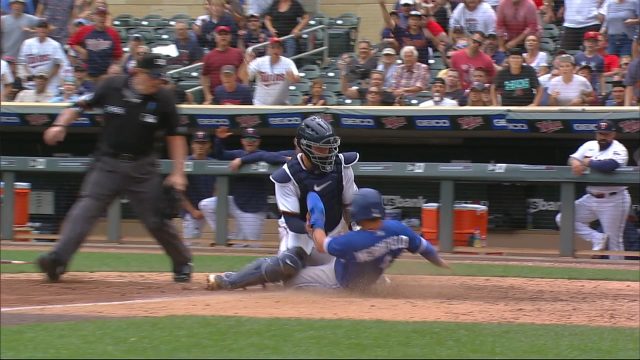
From where Kevin Gausman stood, the entire ordeal reminded him of an old friend.
“That’s the Buster Posey rule, right?” Gausman said after the game. “If you look at the rulebook, you have to give them a place to slide.”
You sure do. MLB’s home plate collision rule was spurred by a May 2011 incident in which Florida Marlins outfielder Scott Cousins ran Posey over during a play at the plate, fracturing the long-time San Francisco Giant’s ankle.
Collisions like those were not uncommon in the game until the one involving Posey, which cost the seven-time all-star the remainder of his season. That’s when the league decided catchers needed to be protected from suffering similar injuries, and baserunners needed to be given clear paths to the plate.
And that’s how we ultimately arrived at what happened Sunday, when Merrifield slid into Sanchez’s knee and controversy ensued. Watching from the Blue Jays dugout long after pitching six scoreless innings earlier in the game, Gausman immediately thought of Posey, who caught 20 of his 33 starts last season. And then he thought about how the call probably wasn’t going to go his team’s way.
“I didn’t think it would be overturned, to be honest,” Gausman said. “I really didn’t.”
Not because Gausman didn’t think Merrifield should’ve been ruled safe, mind you. But because when you’ve been in this league as long as he has, you learn to manage expectations.
MLB replay review can sometimes feel like a cruel game of three-card monte. You saw the play happen right in front of your eyes. It was so obvious. The queen of hearts is clearly right there. How could anyone see it any other way? And then, jack of spades.
Just ask Baldelli and the Twins. Sunday, they were on the wrong side of it. Inevitably, the Blue Jays will be, too. But in this instance, Merrifield made an incredibly heads-up play, and they got a call. No doubt they’ll take it. And no doubt Gausman will convince himself his side isn’t getting the call next time, as well.
“I try not to get my hopes up. Because I’ve seen it. It’s just crushed my dreams so many times,” Gausman said. “So, now I usually just try to be surprised. And that was a good surprise, for sure.”
https://news.google.com/__i/rss/rd/articles/CBMicGh0dHBzOi8vd3d3LnNwb3J0c25ldC5jYS9tbGIvYXJ0aWNsZS91c2Utb2YtY29udHJvdmVyc2lhbC1zbGlkZS1ydWxlLWluc3BpcmVzLWhlYXRlZC10YWtlcy1mcm9tLWJsdWUtamF5cy10d2lucy_SAW9odHRwczovL3d3dy5zcG9ydHNuZXQuY2EvbWxiL3VzZS1vZi1jb250cm92ZXJzaWFsLXNsaWRlLXJ1bGUtaW5zcGlyZXMtaGVhdGVkLXRha2VzLWZyb20tYmx1ZS1qYXlzLXR3aW5zL3NuLWFtcC8?oc=5
2022-08-08 03:47:00Z
1526432071
Tidak ada komentar:
Posting Komentar